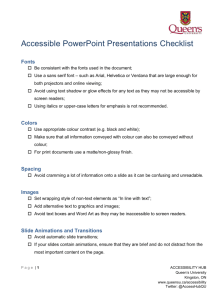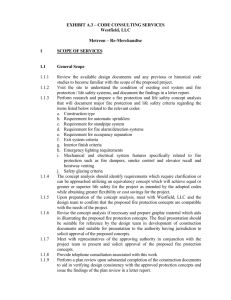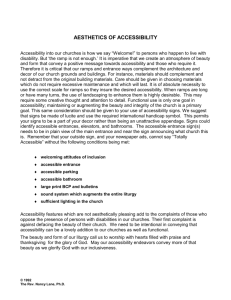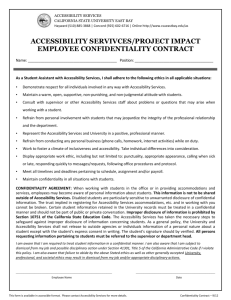Accessibility of Social Networking Services
advertisement
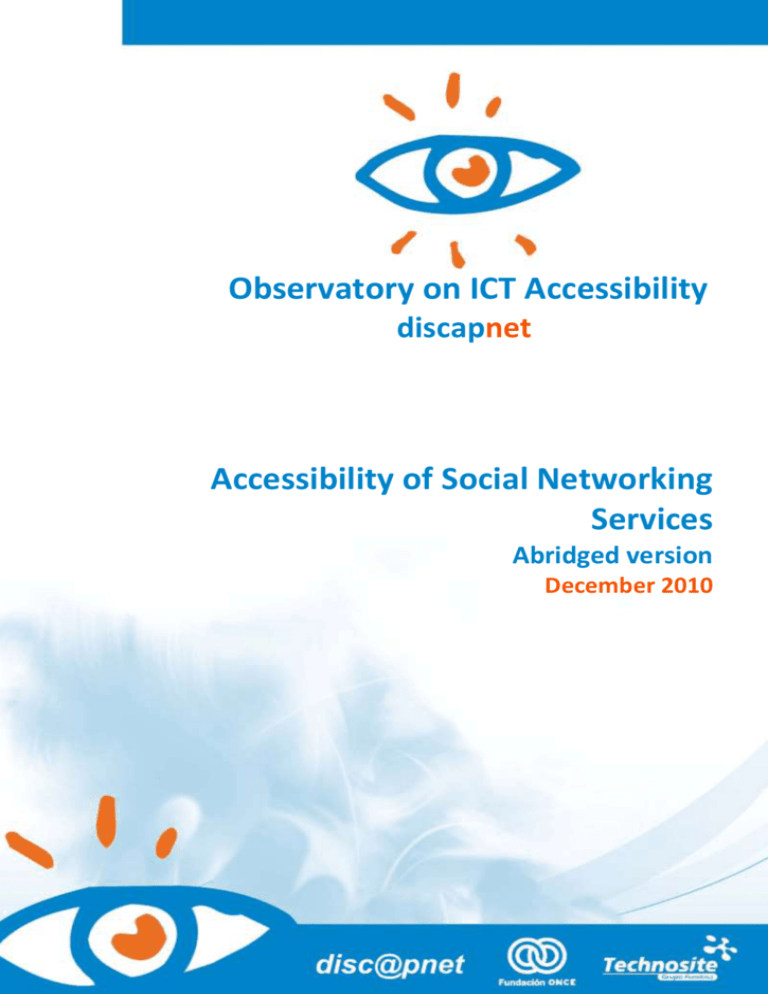
Accesibility of Social Networking Services Observatory on ICT Accessibility discapnet Accessibility of Social Networking Services Abridged version December 2010 1 Accesibility of Social Networking Services Introduction The emergence and spread of social networking services on Internet 1 is one of the most relevant phenomena to emerge in the field of new technologies in recent years. Appearing at the beginning of the 21st Century, in many cases starting out as communication tools for reduced groups of people in specific contexts, such as university students, some platforms have since expanded rapidly, and exponentially, to enjoying coverage and popularity throughout the world. To take but one example, Facebook, set up in 2004, has gone from being a platform used exclusively by North American university students, to being used by 450 million users in over 70 languages, at the last count 2. Spain is one of the countries in which social networking services have taken hold most (and most rapidly). It has been ranked second only to Brazil in use (Nielsen, 2009). The survey conducted by IAB Spain Research (2009) among users of social networks, detected that almost half the respondents use social networking services on Internet as the mains means to obtain information, over and above other Internet services such as digital newspapers, blogs or forums, and also over conventional media, such as television, radio or the written press. Internet-based social networking services are used by 61% of the respondents on a daily basis, with 84% using such platforms more than once a week. Social networking services have led to a change in the panorama of interpersonal relationships, as well as in the means of communication between people and groups, as the use of technology increases. 1 A social network can be considered a social structure made up of people or organisations that are linked to each other, and includes the interaction generated or established by them. Over Internet, such interaction can take place in many different ways: for instance, through comments posted on blogs, the exchange of email messages or participation on forums. With the advent of Web 2.0, which allows for a greater level of interaction on the Web, specific systems have been developed to promote the development of such relationships. Although these systems are commonly known as “social networks”, this report refers to them as “social networking services” in order to distinguish them from the broader concept of “social network”. 2 Sources: www.facebook.com and www.alexa.com 2 Accesibility of Social Networking Services Moreover, given the new approach, possibilities and content between different platforms, these new social practices are being applied in very diverse areas: friendships, communications, professional activities, publicity, outreach and civic action as well as new ways of exercising citizenship, and so on. Anybody with access to Internet and basic knowledge of how to use such tools is a potential user of social networking services. It is therefore a duty of the managers of such services to ensure accessibility, both to the services themselves and to the information they generate, under equal conditions for all users, including people with functional diversity. However, accessibility to social networking services remains incomplete. Many of these services present barriers for people with certain disabilities even for registering, while others may be accessible in that aspect, but later pose difficulties in accessing the available information or when using applications and functionalities. Discapnet’s Observatory on ICT Accessibility has been carrying out sectoral studies on the accessibility of Web portals since 2004. With this type of study, the Observatory fulfils the function of disseminating and highlighting the levels of conformance with standards, as well as the good practices and the main barriers to accessing the Web. The study on the Accessibility of Social Networking Services on Internet carried out by the Observatory offers a panorama of the current level of accessibility of the most widespread social networking services in Spain, with the aim of providing their managers with a diagnosis to help them improve accessibility, and their users with a breakdown of what each service has to offer. 3 Accesibility of Social Networking Services Sample of portals assessed In selecting the social networking services to include in the study, as there is no consensual definition for the concept it was first necessary to define the term for the sample. In some cases, the definitions are very broad and include other concepts, such as blogs or instant messaging services. Our definition of an Internet-based social networking service is based on the following criteria: Allow users to maintain a list of contacts, as well as to establish new contacts; Allow users to find new contacts using their list of contacts; Allow users to upload content (whether text, audiovisuals or both) and that their contacts have access to such content and they can comment on them and forward them to other users, etc. Eight social networking services were selected from among the platforms that offered these services, and based on the following criteria: 1. Significant penetration of the platform in Spain (number of users, media coverage, etc.). 2. Range of topics covered by the platform (general, thematic, microblogging, etc.). Based on the above criteria, the following social networking services were included in our study: 1. Facebook: www.facebook.com 2. Tuenti: www.tuenti.com 3. MySpace: www.myspace.com 4. Xing: www.xing.com 5. LinkedIn: www.linkedin.com 6. Twitter: www.twitter.com 7. Flickr: www.flickr.com 8. Windows Live Spaces: http://home.live.com/ 4 Accesibility of Social Networking Services Methodology The Observatory uses an innovative methodology developed by Technosite, based on W3C/WAI recommendations 3, and combines the technical analyses carried out by accessibility experts with the usability and accessibility assessment by users themselves. As a novelty and enhancement to earlier studies carried out by the Observatory, in order to make the findings of both groups comparable, similar evaluation criteria were designed for both the technical analysis and that of the users. Thus, twelve aspects or criteria were defined to synthesise most of the W3C/WAI (WCAG 1.0) Guidelines for Content Accessibility corresponding to Levels A and Double-A, as well as the Web 2.0 (WCAG 2.0) Guidelines for Content Accessibility. The criteria analysed were the following: Multibrowser access; Navigation and orientation; Forms; Images; Structure; Separation between presentation and content; Colour; Layout tables; Data tables; Script; Multimedia content; and PDF documents. Each of these criteria had a certain number of sub-criteria, totalling 30. In the case of users’ experiences, the different criteria were set out in a series of questions on a questionnaire to be answered by a sample of users after they had carried out a number of tasks on each of the eight platforms included in the study. The tasks, or processes, were the same as those carried out in the technical analysis: Registration, uploading and viewing content, and adding contacts. The sample of users was made up of eight people with different profiles: a user with no disabilities; two blind users; a partially sighted user; a user with intellectual impairment 4; a user with hearing impairment; and two users with limited movement in their upper limbs. Each user only evaluated the criteria and sub-criteria corresponding to the accessibility requirements for his/her profile (for instance, only the blind users analysed the criterion for Images). However, the sample also included a user with no disabilities who was able to evaluate more criteria than the average user. Analysis of the sub-criteria was carried out, where relevant, taking into account two key variables of website accessibility: severity of the barrier, and frequency of its occurrence. 3 4 W3C/WAI: The World Wide Web Consortium’s Web Accessibility Initiative. For further details, visit: http://www.w3.org/WAI An easy-to-read version of the questionnaire was drawn up for users with intellectual impairment. 5 Accesibility of Social Networking Services The methodology followed, and the drawing up of the findings of the technical analysis and user experiences, was highly quantifiable and based on statistical criteria. From the calculation of the conformance degree for each criterion and the negative points due to barriers a single score was obtained for each portal in each of the types of analysis (technical analyses and users’ experiences). In publishing the findings, and in order to provide data integrating the results obtained for each portal, the total score was converted into a rating system of stars. Thus, the technical analysis awarded up to five stars and users’ experiences another five. The conversion was carried out according to the following scale, on which those social networking services which reached almost full conformance with the criteria analysed were especially pondered: - 0 stars: scores of 0 to 4.49, totally inaccessible website. - 1 star: scores of 4.5 a 6.49, very deficient level of accessibility. - 2 stars: scores of 6.5 a 7.99, deficient level of accessibility. - 3 stars: scores of 8 to 8.99, moderate level of accessibility. - 4 stars: scores of 9 to 9.49, good level of accessibility. - 5 stars: scores of 9.5 to 10, excellent level of accessibility. Regarding the global score for each criterion, as well as for each of them on each portal, a final rating system was also devised, based on a “traffic light” system, to indicate the degree of conformance with the criteria in each case: - Red light / major barrier: scores between 0 and 6,49. - Amber light / moderate barrier: scores between 6,5 and 8,99. - Green light / minor barrier or no barrier: scores between 9 and 10. The technical analysis of the sample of portals included in this Observatory study was carried out in June 2010, and the users’ experiences in October 2010. Findings Table 1 shows the scores obtained for each social networking service included in the sample of Discapnet’s Observatory on ICT Accessibility, based on the technical analyses and users’ experiences, and in relation with the accessibility of these portals. 6 Accesibility of Social Networking Services Table 1. Levels of accessibility of social networking services Web site LinkedIn Flickr Xing Twitter Facebook Windows Live Spaces Tuenti Level of accessibility* Technical analysis 3 stars Level of accessibility* User experience 2 stars 2 stars 2 stars 1 star 1 star 1 star 3 stars 2 stars 2 stars 2 star 1 star 1 star MySpace 1 star General 1 star 2 stars *Minimum rating: 0 stars. Maximum rating: 5 stars. The social networking services selected for the sample scored an average of one accessibility star (corresponding to a very deficient level of accessibility) based on the technical analysis and two stars (corresponding to a deficient level of accessibility) from the experiences of users with different profiles of disability. The conclusion, therefore, is that the level of accessibility of the most popular and commonly used social networking services in Spain is quite low. LinkedIn is the platform rated as having the highest level of accessibility from the technical viewpoint, with three stars out of five (moderate accessibility). It was followed, some distance behind, by Flickr and Xing, with two stars (deficient accessibility), while the rest of the platforms analysed rated one or no star. These results are shown in Figure 1, below. Figure 1. Accessibility stars from the technical analysis of social networking services 7 Accesibility of Social Networking Services Based on users’ experiences with these platforms, the service with the greatest level of accessibility is Flickr (3 stars), followed by Xing, Twitter, Facebook and LinkedIn, with two each. On the contrary, the lowest ratings on accessibility, in the users’ opinions, were MySpace, Windows Live Spaces and Tuenti, with one star (very deficient accessibility) each. These results are shown in Figure 2, below. Figure 2. Accessibility stars from users’ experiences of social networking services These findings lead to the conclusion that, in general, users’ evaluations of accessibility are usually somewhat more positive than the corresponding technical analyses, because they are accustomed to having to overcome barriers in order to navigate. This does not mean that there are no barriers. In any case, in designing the methodology an attempt was made to reduce the bias between technicians and users when assessing the accessibility of the platforms, by making the users aware of the typical problems and barriers that make access to Web pages difficult. The findings show that this was achieved, at least in part, since in some cases the score given in the technical analysis is higher than that given to the same platform by the users (for instance, LinkedIn was granted three stars in the technical analysis and only two by the users) and in other cases, both scores were similar (one star level of accessibility in both types of assessment for Windows Live Spaces, or two for Xing). Figure 3 shows the combined findings of the technical analysis and the users’ experiences for each portal: 8 Accesibility of Social Networking Services 5 User's Experience 4 Flickr 3 Facebook LinkedIn Xing Twitter 2 Tuenti Windows Live Spaces 1 MySpace 0 0 1 2 3 4 5 Technical Analysis Figure 3. Combined levels of accessibility from the technical analysis and user’s experience of social networking services As the above graph shows, the results of the different services in the technical analysis were quite low, with only LinkedIn scoring higher than average in terms of accessibility stars and achieving a “moderate” level. Flickr and Xing had a “deficient” level of accessibility; Twitter, Facebook and Windows Live Spaces had a “very deficient” level; whereas Tuenti and MySpace were, technically, completely inaccessible. On the other hand, the results from the users’ experiences were less strict and more varied: Flickr obtained a “moderate” level of accessibility; Xing, Twitter, Facebook and LinkedIn, “deficient”; and Tuenti, MySpace and Windows Live Spaces, “very deficient”. None of the platforms were totally inaccessible according to the users. Regarding the results for the accessibility criteria for the sample of portals analysed by the Observatory, shown in the table below, the different criteria analysed rated a major degree of penalization, on average, from the technical analysis, and a moderate degree from the users’ viewpoints. For the technical analysis, several criteria had a major degree of non-conformance (Separation between presentation and content, Use of Script and PDF Documents), and two criteria presented a minor degree of non-conformance (Multi-browser access and Colour). On the other hand, for the users’ experiences, the criteria with major non-conformance were those of Images and use of 9 Accesibility of Social Networking Services Script, while there were five showing minor degrees of non-conformance: Multi-browser access, Colour, Forms, Layout tables, and Multimedia content. Table 2. Degree of non-conformance of the criteria assessed in the technical analysis Average penalization Technical analysis Criteria Multi-browser access Colour Forms Data tables Layout tables Multimedia Structure Navigation and orientation Images Separation between presentation and content Scripts PDF documents AVERAGE 0,00 0,07 0,17 0,09 0,23 0,33 0,25 Degree of penalization Technical analysis Minor Minor Moderate Moderate Moderate Moderate Moderate 0,26 Average penalization User’ experience 0,01 0,06 0,06 0,19 0,07 0,06 0,16 Degree of penalization User’ experience Minor Minor Minor Moderate Minor Minor Moderate Moderate 0,18 Moderate 0,22 Moderate 0,39 Major 0,45 Major 0,26 Moderate 0,66 0,78 0,43 Major Major Major 0,36 -0,33 Major -Moderate NOTE: Penalizations range from 0 to 1 point. Figure 4 shows the scores for the different criteria obtained from the technical analysis, for the eight platforms included in the study. Each criterion analysed can thus be compared across all the results of the platforms. The criterion of Multi-browser access obtains a high score (minor barrier) on all the portals, whereas for the other criteria the scores vary significantly from one portal to another. The criterion of Script is the one that presents most barriers on all the platforms, with the exception of LinkedIn, where the barrier was minor. 10 Accesibility of Social Networking Services Figure 4. Accessibility scores from the technical analysis by verification criterion, for the eight platforms included in the study Conclusions and technical recommendations The conclusions drawn by Discapnet’s Observatory on ICT Accessibility regarding accessibility to social networking services are as follows: 1. The social networking services showed a low level of accessibility: they obtained an average of one accessibility star from the technical analysis (very deficient level of accessibility) and two stars from the users’ experiences with different profiles of disabilities (deficient level of accessibility). 2. Of the sample of platforms analysed, LinkedIn showed the highest technical level of accessibility, with three stars (moderate level of accessibility), and a further two from the users’ 11 Accesibility of Social Networking Services assessment. It was followed by Flickr and Xing, with two stars from the technical analysis (deficient accessibility) and three and two, respectively, from the users’ experience, while the remaining platforms analysed obtained one star or none from the technical analysis (very deficient accessibility or totally inaccessible), with varying results from the users’ evaluation (between none and two stars). 3. As mentioned earlier, the platform with the highest technical score, according to the experts in charge of the assessment, was LinkedIn (3 stars). Those presenting the greatest barriers to accessibility, from a technical viewpoint, were Tuenti and MySpace (0 stars). 4. The most accessible and usable platform, according to users, was Flickr (3 stars). The lowest levels, in the opinions of users with different profiles, whether disabled or not, were Tuenti, Windows Live Spaces and MySpace (1 star). 5. In general, and for the sample of platforms analysed by the Observatory as a whole, the different criteria analysed rated a major degree of penalization from the technical analysis, and a moderate degree, from the users. 6. The criteria with the highest levels of conformance were those of Multi-browser access and Colour. On the other hand, the criterion showing the greater number of bad practices was that of non-accessible Scripts. 7. The scores obtained for both the global rating of the platform and the specific criteria included in the assessment were slightly higher when given by the users than those from the technical analysis. This is a common finding, and is due to the fact that users are accustomed to overcoming barriers in order to be able to navigate. However, this does not mean there are no barriers to access. With a view to encouraging certain actions that can help to improve accessibility to the social networking services, Discapnet’s Observatory on ICT Accessibility team has drawn up the following recommendations: Adjust HTML and CSS codes to W3C guidelines. Correct code can be suitably interpreted by users’ navigation devices and, in particular, by the special devices used by people with functional limitations. Carry out an accessible development of Forms, as these are the tools for interaction between the user and website management. The inability to use forms limits the capacity to 12 Accesibility of Social Networking Services register with different networks, look for and add new contacts, search for Content and, in general, limits the interactive function of the website. Apply text equivalents to the Images on the website; the description must be suitable, that is, it must describe the information transmitted by the non-text element. While current design tools make this task easier, correct application of this criterion depends on the good judgment of the people responsible for the maintenance of the website which, in turn, depends on correct training. Pay attention to the correct use of headers, as these help to orient users with certain navigation tools and, in general, ensure clarity of Content for all users of the website. Use, in style sheets, proportional measures, as these ensure users can control how Content appears on the screen. Also verify always that the website can be visited without using these style sheets, as there are users (although each time fewer in number) who, due to the features of their navigation devices, are unable to use them. Pay attention to the use of images for links. Links are an essential element of Web pages, based as they are on hypertext. The text equivalent for every image must inform about the destination of the link. Care must also be taken to avoid new navigator sessions being opened without informing the user, as people who navigate without seeing the screen may get disoriented or lost. Make sure that the contrast between the content and the background, especially when using images, follows criteria that ensure users can distinguish them. Certain visual impairments, such as colour blindness, as well as the progressive deterioration of the visual organs experienced by everybody, mean that this criteria should not be considered minor. Include data tables only when strictly necessary, and always complying with the established accessibility criteria for their design and construction. Data tables are useful for transmitting large amounts of information in a reduced space, but unless they have been designed according to accessibility criteria they are useless for people unable to see them as a whole. Developers must therefore pay especial attention to this so that people with visual impairment do not miss out on important information transmitted by the Web pages. Always provide an alternative to programmed objects, such as scripts. This type of object enhances certain aspects of Web design, but not all navigation tools are able to recognise them. 13 Accesibility of Social Networking Services Apply accessibility criteria to both HTML content and to documents in other formats (PDF, Word, etc.). Users must be guaranteed access to all Content, including downloadable documents linked to the website. Provide accessible multimedia players, since disabled people currently come up against many barriers to accessing multimedia content on the portals. 14





